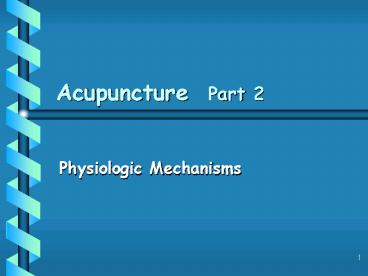Acupuncture Part 2 - PowerPoint PPT Presentation
1 / 33
Title:
Acupuncture Part 2
Description:
Neural (non-opioid) segmental gate theory. Neural (opioid) humeral theory ... certain AP points correlate with symptoms for viscera at the same spinal segment ... – PowerPoint PPT presentation
Number of Views:80
Avg rating:3.0/5.0
Title: Acupuncture Part 2
1
Acupuncture Part 2
- Physiologic Mechanisms
2
Physiologic Mechanism
- Local inflammation and muscular effects
- Neural (non-opioid) segmental gate theory
- Neural (opioid) humeral theory
- Somatovisceral (autonomic) effects
- Bioelectrical theory
3
Local Effects De Qi Sensation
- Caused by sequential activation of
- A-delta
- C-fiber
- Group II fiber
- Blocked by local anesthesia
- Requires intact nervous system
- Not seen at non-AP points
4
Local Effects De Qi Sensation
5
Local Effects De Qi
- PRABM response in horses (pilomotor reaction
along bladder meridian)
6
Local Effects
- Muscle Reaction
- contraction around the needle
- ipsilateral flexion
- contralateral extension
- Leads to tissue relaxation and relief of muscle
spasm - Principle of trigger point therapy
7
Local Effects
- Anatomically, AP points are sensitive to
microtrauma - Releases Hagemans Factor XII
- activates clotting cascade, complement cascade,
plasminogen and kinins - Produces local PGs
- Mast Cell degranulation
- histamine, heparin and kinin protease
- Releases Bradykinin
8
Local Effects Event Sequence
- Vasoconstriction 15-30 sec
- Quasi-control 10 sec-2 min
- Vasodilatation 2 min-2 wk
- ? local immune status
- ? local BF
- ? local muscle and tissue relaxation
9
Physiologic Mechanism
- Local inflammation and muscular effects
- Neural (non-opioid) segmental gate theory
- Neural (opioid) humeral theory
- Somatovisceral (autonomic) effects
- Bioelectrical theory
10
Segmental Analgesia
- Evoked by high frequency, low intensity
stimulation of AP point - Rapid onset
- Diminishes after cessation
- Not reversed by naloxone
11
Types Speed of Axons
12
Gate Theory of Melzack Wall
- A-delta fibers conduct information to spinal cord
before slow conducting C fiber information
arrives - These fibers lead to inhibition (pre-synaptic) of
information carried by the C fibers (pain)
13
Gate Theory of Melzack Wall
- Fast transmitting fibers lead to pre-synaptic
inhibition
14
Physiologic Mechanism
- Local inflammation and muscular effects
- Neural (non-opioid) segmental gate theory
- Neural (opioid) humeral theory
- Somatovisceral (autonomic) effects
- Bioelectrical theory
15
Humeral Mechanisms
- Interaction of AP point with
- Spinal Cord
- Brainstem
- Higher Centers
- Mediated through neurochemical interactions
16
Opioid Humeral Mechanisms
- Take 30-40 minutes
- Persists for hours
- Generalized effect which is reversed by naloxone
- Transferable from one patient to another
- Tolerance to and cross tolerance with morphine
develops
17
Opioid Humeral Mechanisms
- Dexamethasone ? ß-endorphin levels and ? AP
analgesia - Adrenalectomy ? ß- endorphins and ? AP analgesia
- Hypophysectomy eliminates AP analgesia
18
5HT Humeral Mechanisms
- 5HT ? in systemic circulation by 30-40
following AP - CNS maintains balance between 5HT and
ß-endorphins - endorphins alter 5HT release (regulating pain
threshold in spinal cord) - ? 5HT blocks effects of naloxone
19
Other Humeral Mechanisms
- Potentiators of AP effects
- substance P
- histamine
- cGMP
- Antagonists of AP effects
- GABA
- cAMP
20
Humeral Mechanisms Systemic Endocrine Effects
- Improves BF to pituitary axis and ? capillary
wall enzyme - Releases somatotropin in chronic pain patients
- Induces LH release
- Stimulates prolactin and oxytocin release
- Modulates thyroid function
21
Physiologic Mechanism
- Local inflammation and muscular effects
- Neural (non-opioid) segmental gate theory
- Neural (opioid) humeral theory
- Somatovisceral (autonomic) effects
- Bioelectrical theory
22
Somatovisceral Reflex Autonomic Effects
- AP stimulation converges with visceral efferent
resulting in reflexive interactions with internal
organs (along internal connecting meridians) - Regionally located
- Referred pain regions
23
Autonomic Effects
- Indication of certain AP points correlate with
symptoms for viscera at the same spinal segment - Bring descending influence only to the level of
stimulation, ipsilaterally - Specificity of AP points related to somatotropic
location
24
Autonomic Effects
- Referred pain
- Convergence of Somatic and Visceral inputs in CNS
- dorsolateral funiculus
- spinothalamic tracts
- Visceral A-delta fibers reflexively affect
muscles - inflammation and cramping
25
Autonomic Effects
- AP of somatic structures can treat internal
organs (through meridian connections) - AP modulates both arms of ANS
- Segmental sympathetic vasodialation
- Highly specific
- Stimulate a specific AP point, get a specific
physiologic change
26
Autonomic Effects
- AP stimulation of GV26 altered BP, HR and RR in
dogs undergoing induced shock - Mortality in controls 100
- Mortality in AP-treated 25
27
Autonomic Effects
- Stimulation of PC6
- ? lipid peroxidation of the heart
- ? coronary blood flow
- improved cardiac rhythm
28
Autonomic Effects
- Potentiators of AP effects
- ß-adrenergic
- eserine
- Antagonists of AP effects
- ?-adrenergic
- atropine
29
Physiologic Mechanism
- Local inflammation and muscular effects
- Neural (non-opioid) segmental gate theory
- Neural (opioid) humeral theory
- Somatovisceral (autonomic) effects
- Bioelectrical theory
30
Bioelectric Theory
- DC energy channels correspond to AP meridians
- Points of low electrical resistance on the skin
correspond to AP points
- Bioelectric
- Amplifier
- Conductor
- Bioelectricity
- Acupuncture
- AP point
- Meridian
- Qi
31
Other AP Effects
- Anti-fever
- GI regulation
- Anti-inflammation effect
- Blood pressure regulation
- Stress relief
- Aging prevention
- Performance enhancement
- Improving microcirculation
- Face lift
32
Transcutaneous Nerve Stimulation (TENS units)
- Well accepted method to produce analgesia
- Electrodes hard to apply to haired animals
- May just be acupuncture without needles
33
Conclusions
- AP represents part of an ancient system of
comprehensive health care - As scientific knowledge expands, modern
correlations are being developed which help
translate this ancient wisdom into today's terms - May the Qi be with you!!!































